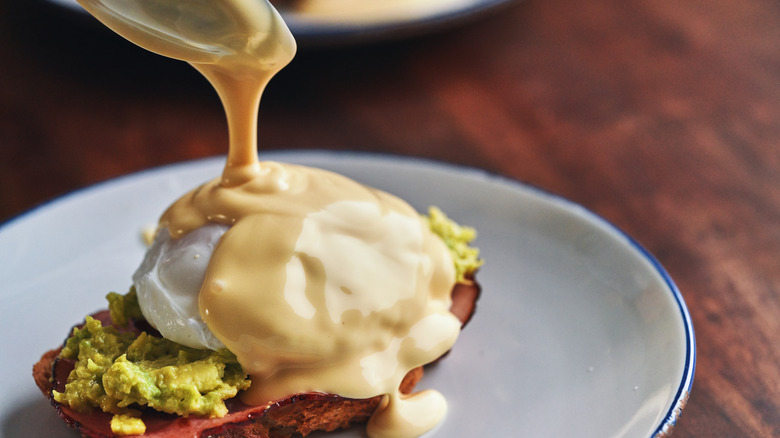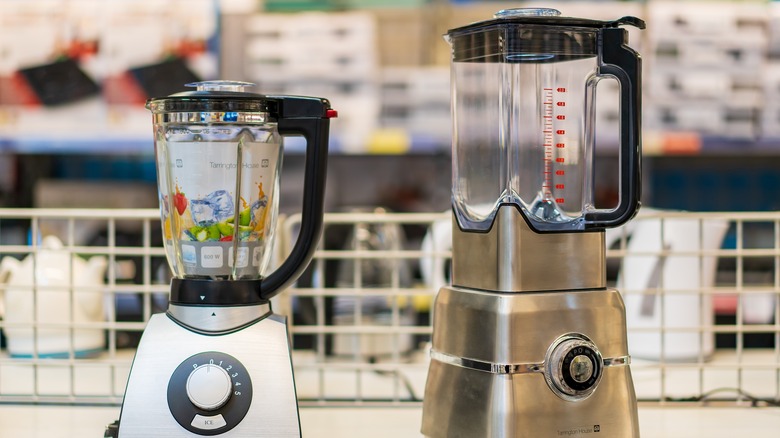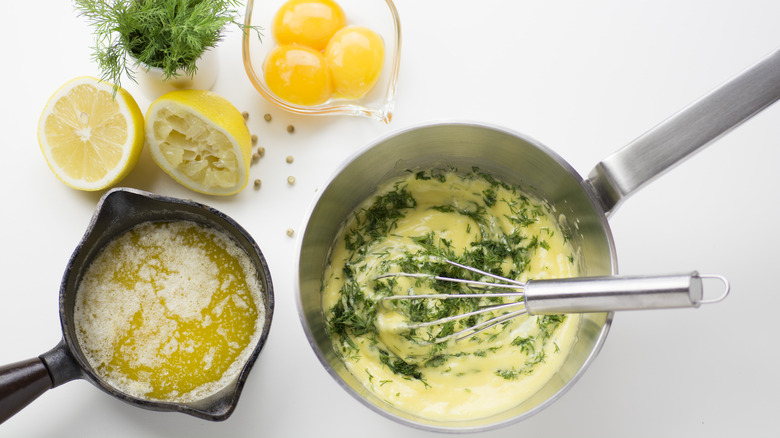The No-Fail Blender Method For Quick, Easy Hollandaise Sauce
Hollandaise is bright and creamy — it's a beautiful accompaniment for asparagus, eggs Benedict with holiday ham, or scallops — but it has a reputation for being difficult. One of the biggest problems with hollandaise is that its ingredients don't like to play nice: lemon juice and melted butter are basically water and oil. And the egg yolk, the ingredient that's supposed to bring everything together, has to be treated just right. If it's not, it'll leave your hollandaise (and your heart) broken. And don't get us started on the whisking. So much whisking.
What if we told you we had a solution that would work every time, and there was no whisking involved? No bain-marie? No crying over broken hollandaise? Enter the blender.
Using a blender makes a no-fail hollandaise because it mechanically creates a bomb-proof emulsion. It does what your whisking arm can only dream of, powerfully dispersing the butter's microscopic fat droplets into the liquid elements of the sauce's ingredients (it can whip up a quick whipped cream, too). The blades whip the lecithin of the egg yolk into shape, demanding it hold the fat and water molecules together.
Simply froth the egg yolks, water, salt, and lemon juice in the blender until pale and fluffy. Then, in a slow and even stream, add hot, melted butter. Blend until thick and creamy. Behold: You have a batch of hollandaise that came together with neither sweat nor tears.
Equipment tips for getting it right every time
You can use either a stand blender or an immersion blender for this method. The basic function is the same: The blades whir and create an emulsion regardless of whether they're facing up or down.
That said, blender hollandaise will work best if your tool isn't oversized for your batch. Stand blenders come in all sorts of shapes and sizes, from wide and square bottoms to conical jugs to inverted cups like the Nutribullet. If your blender blades don't touch the egg yolk, this method won't work. If your blender is too big or the blades sit too high to blend a single yolk, you may need to make a larger batch of hollandaise.
Alternatively, you could use a smaller tool like a handheld immersion blender. When using an immersion blender, make sure the vessel you're blending in is narrow enough to just barely fit the head of the blender — once again, the blades have to come into full contact with the ingredients.
If the size of the blender isn't correct, the sauce won't emulsify properly. Some of the ingredients will get left behind, the emulsion won't be balanced, and it'll never come together. Save yourself the heartbreak by selecting the right-sized tool for the job.
Temperature tips for perfect hollandaise
Temperature can still make or break your hollandaise. The reason it's traditionally whisked in a bain-marie (and not in a bowl like a vinaigrette) is because eggs thicken as they cook. The proteins in a yolk begin to coagulate at 149 degrees Fahrenheit, so you need the yolks to get pretty toasty. You don't want the eggs to scramble, just thicken, like in a custard or pastry cream.
In this case, the hot butter cooks the eggs as it's incorporated. It's important that the butter is hot enough to make this magic happen, so don't just pre-melt it and let it cool. In an episode of The Food Lab, J. Kenji Lopez-Alt says that the butter should reach 220 degrees Fahrenheit on an instant-read thermometer. If you don't have a thermometer, the mixture should be sputtering and foaming; as the temps rise above 212 degrees, water starts to boil out and causes a ruckus.
Using room-temperature egg yolks and lemon juice will help the process along considerably, as cold eggs may reduce the temperature of the butter enough that the yolks won't thicken. And Molly of Bon Appétit's test kitchen has another trick: pre-heat your blender jug with hot water before starting.
Once you've made your hollandaise, pour and scrape every last bit out of the blender canister and eat it right away. Whatever you do, don't let it cool down, or your blender's hard work will go to waste.


